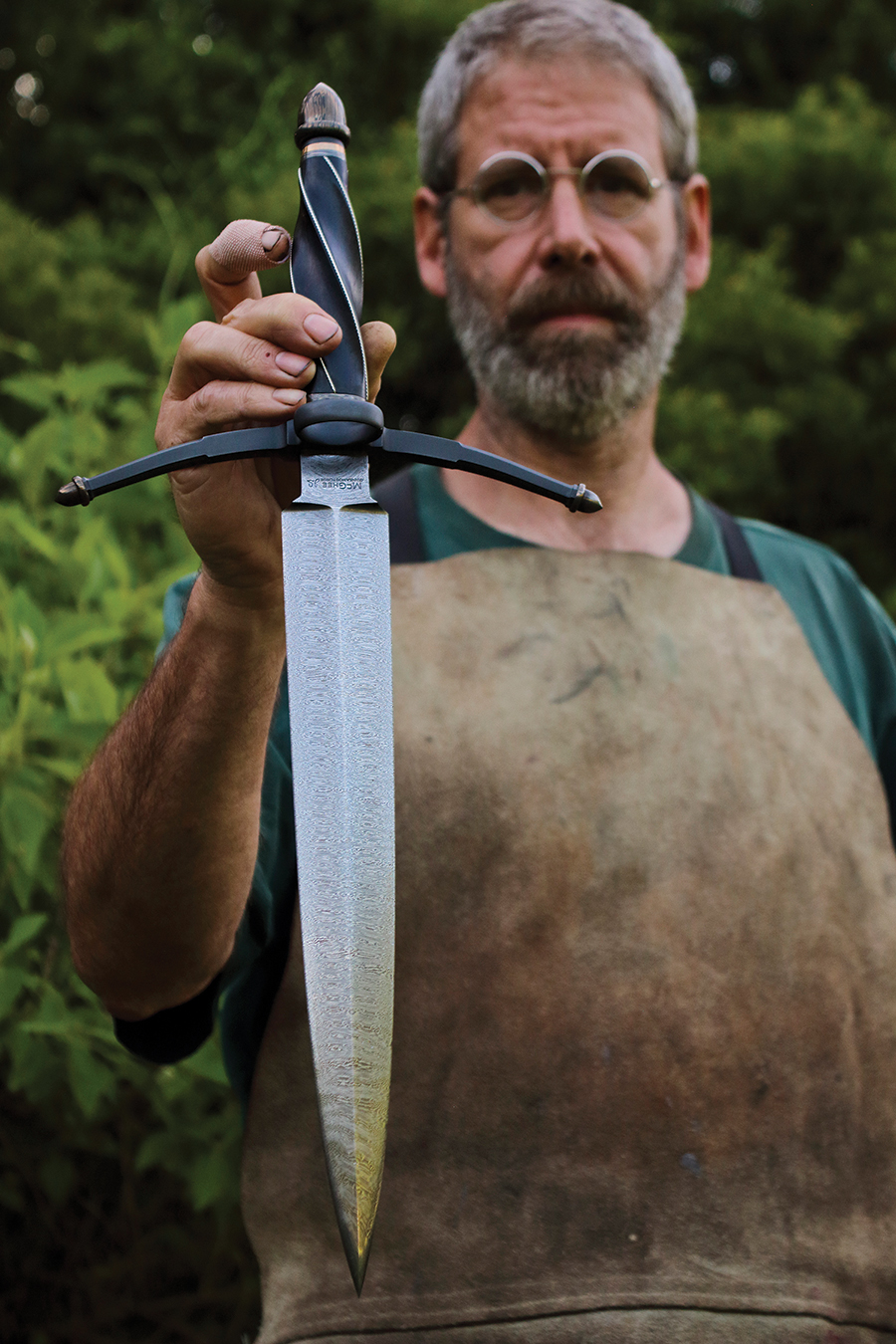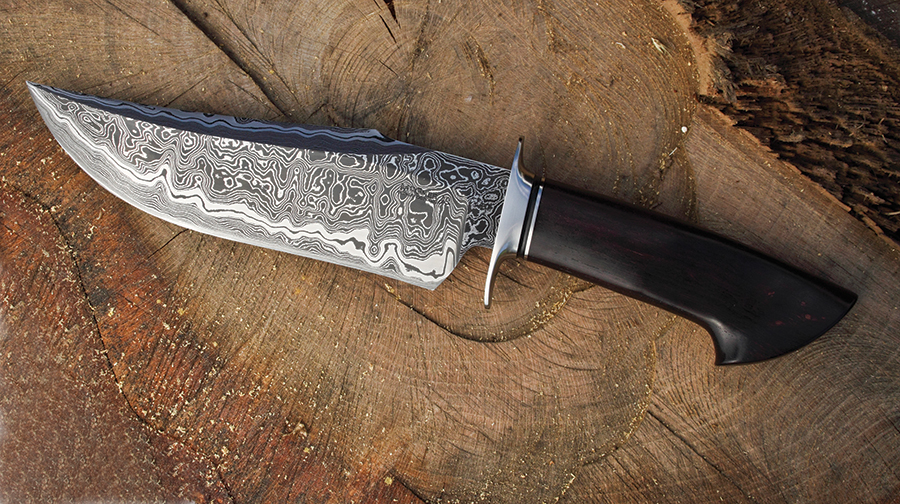A Bladen County Master Smith forges mythic steel
By Virginia Holman • Photographs by Lydia McGhee
If you’re a fan of Game of Thrones, you know that Valyrian steel is the finest ever forged, its process lost during the Doom. The surviving swords are highly valued objects, imbued with magic capable of destroying a White Walker. What you may not know is that author George R.R. Martin’s model for Valyrian steel was real-world Damascus steel. This legendary steel was named by crusaders in 900 A.D. Syria, who witnessed these damask-patterned steel blades shatter opponents’ swords without dulling. The secret to creating Damascus steel spanned continents, but was so closely guarded that eventually it was lost for many centuries.
Damascus steel captured the imaginations of many, not only due to its superior sharpness and unique beauty, but because of its fascinating lore. Crusaders reported that the Saracens’ Damascus blades could slice a falling feather or a silk scarf tossed in the air. There were also claims that the steel was infused with magic during the “quenching.” In a 1981 New York Times article, Dr. Helmut Nickel (yes, that’s his real name), then curator of the Arms and Armor Division of the Metropolitan Museum of Art in New York, noted ancient sources that claimed quenchings as varied as “dragon blood or donkey urine
. . . the urine of redheaded boys or that from a ‘three-year-old goat fed only ferns for three days.’” The same article also notes that “writings found in Asia Minor said that to temper a Damascus sword the blade must be heated until it glows ‘like the sun rising in the desert.’ It then should be cooled to the color of royal purple and plunged ‘into the body of a muscular slave’ so that his strength would be transferred to the sword.”
These vivid legends endured, doubtless used to intimidate enemies long before they met on the battlefield. They also fueled the imaginations of children like the young Scott McGhee, who grew up to become one of the finest knife and sword makers this side of Valyria.
The morning I journey to Master Bladesmith Scott McGhee’s workshop in rural Bladen County feels vaguely otherworldly. The rain pours down in torrents until U.S. 74 becomes a shallow running river. Traffic slows. Eventually, I see why: A light pickup truck without ballast is ahead, spun 180 degrees against the concrete barrier. A couple of miles on, the rain refuses to relent; I feel my tires shudder and I pull over in Leland to wait for a break in the weather. Once the rain passes, mist hovers above the swampland flanking the road, the same swamps that surged with whitewater during Hurricane Matthew.
Eventually, toward Clarkton, the land begins to rise and dip, and the road stretches ahead like a lonely gray ribbon.
When I arrive at Bluefield Acres farm, Scott’s in his shop with Lydia, his wife and business partner, and their stouthearted cattle dog Angus. They look like something out of a storybook. He’s tall and rangy with a close-cropped beard, his intense blue eyes framed by small gold-rimmed spectacles. His feet are shod with heavy work boots, and he’s wearing, of all things, an army green wool kilt. Lydia is tall and fine boned with piercing sky-blue eyes, her tanned face framed by a cloud of silver corkscrew curls.

Scott began making knives seriously in 2009. Prior to that, he was a forester and then an arborist. The recession and an on-the-job freak accident that left him with three broken ribs were the catalysts for his career change.
“I was blacksmithing as a hobby,” he says in his broad North Carolina drawl, “and my wife posted a picture of it on her Facebook page —”
“— and,” Lydia breaks in, “a friend of mine from high school said he wanted to buy it, so we came up with a price —”
“— and I sold my first knife,” Scott says.
“That’s when the lightbulb turned on, and we started to think that this could be a new career for Scott.”
Truth be told, it’s not as if Scott woke up one morning and decided to become a knife maker; he’d been blacksmithing for decades. “When I was about 14, my uncle left some of his blacksmithing tools and a horseshoe forge in my parents’ workshop.” Scott was drawn to them and secretly began trying to teach himself how to forge. “I found some great big lumps of boiler coal and figured out how to set them on fire in the forge. It was a complete disaster.” His secret was out when fumes forced him out into the yard where — gasping for breath — he collapsed from heatstroke in front of his mother, Peggy McGhee, just as she arrived home from her job as Franklin County school superintendent.
“I was lucky. My mother was a lifelong educator, so she didn’t punish me. She knew I needed instruction or I was going to kill myself or burn something down. Eventually, she got me enrolled at the Penland School of Crafts in the second ever blacksmithing class.”
That was in 1980, and the blacksmithing workshop at Penland was spartan, just a small room set off from the glassblowing workshop. “All it had was one outlet, one lightbulb, a rack of steel, an acetylene cutting torch, a few forges, some tongs, anvils and hammers. That’s all there was,” Scott remembers. “The instructor came in, and he was grizzled for his age, smoking Camel cigarettes, wearing a cut-off t-shirt and a pair of cut-off shorts that had been patched and patched and patched. His entire belly was black with slag that was buried in it from blacksmithing, and his shorts had all these burn holes in them. He said, ‘I don’t know what they told you about this class, but it’s all bullshit. Look around here, boys and girls, there is nothing here. We’re making tools. You will make three sets of tongs, three hammers, and three anvil tools. Once you complete making said tools, you can make anything you want.’ So we supplied the entire shop. It was also the first place I was introduced to basic pattern-welded or Damascus steel. At the time, our instructor was one of about six people in the country who knew how to create and work with Damascus.” Moreover, Scott notes how valuable that experience was to him as a craftsman and artist. “If you can create the tools you use and heat the steel in a forge you made, then there’s more of you in the blade.”
Scott’s designs are inspired by the natural world. “I see knives in everything. I can look at the shape of a raptor’s talons or the bend in a tree branch, and it inspires me to create a knife.” His process is all freehand. “I never know the length of a knife I’m making until I make it.” He brings out one of his many artist’s notepads. “First, I make a sketch, never on graph paper, because if you sketch on graph paper, you are always using those straight lines as a reference, and knives are all about curves and balance.” He then uses his artist’s rendition to forge the knife. “I’ll make a blueprint and then a wooden pattern, so I have something to forge to. Sometimes, if I really like a knife, I will make a metal pattern.” A metal pattern allows him to lay the metal on the hot steel to check the shape as he forges the blade. He also outlines the blade on the anvil as a point of reference.

It all sounds rather straightforward until you look at Scott’s knives: elegant, perfectly balanced precision blades, and then you begin to believe that he, too, imbues his blades with magic. He hands me a tactical knife that he’s forged from Damascus steel. When you hold one of Scott’s knives, it truly feels like an extension of your body. It’s perfectly calibrated. The Damascus blade shimmers like rippled water. The patterns on the knife aren’t haphazard but rendered with great intention.
Lydia says, “Scott has this ability, I don’t have it, to visualize something in three dimensions. He gets an idea for a specific damask pattern and he is able to render it from the steel.” To control the pattern he creates a billet, a block of different carbon content steels that will forge well together. One usually has a higher nickel content than the other. He hands me a billet of steel ready to be forged; it is stacked with 35 layers of steel, each as thin as phyllo dough. Once the steel is forged, Scott will hammer and fold the steel over and over, sometimes twisting it, to get the exact pattern he wants. Like a great sculptor, he sees a blade’s shape and pattern in the block of steel, and patiently coaxes it into being. This is a testament to his skill and craftsmanship, but I have to admit, the leap from billet to blade seems a sort of alchemy.
Others think so too. He’s now a full-time bladesmith and has achieved the highest level of certification, Master Smith, from the rigorous American Bladesmith Association (ABS). There are only 119 Master Smiths in the world. His gorgeous custom knives sell as soon as Lydia posts them online, and two of his tactical designs have been leased by Böker for limited edition production runs. As he’s become better known, everyone from chefs to students has sought him out. (Chef Lee Grossman at Bento Box commissioned a set of custom chef’s knives.) For a time, Scott taught out of his workshop, but now that his business is booming, he teaches for the ABS at “hammer-ins” across the country to keep the art of the forged blade alive.
To see more of Scott McGhee’s work and process, visit www.guineahogforge.com. To order kitchen or carrying knives, email [email protected]
Want to learn the art of the forged blade? Resister for Scott’s week-long introductory class at Haywood Community College online at www.americanbladesmith.com or call 828-627-2135.
Author Virginia Holman, a regular Salt contributor, teaches in the creative writing department at UNC Wilmington.


